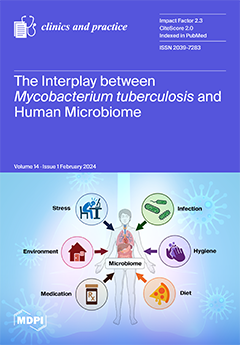Introduction: Mental disorders, smoking, or alcoholism and benign prostate disease are highly prevalent in men. Aims: To identify the relationship between mental disorders, smoking, or alcoholism and benign prostate disease. Methodology: A prospective multicenter study that evaluated prostate health status in 558 men
[...] Read more.
Introduction: Mental disorders, smoking, or alcoholism and benign prostate disease are highly prevalent in men. Aims: To identify the relationship between mental disorders, smoking, or alcoholism and benign prostate disease. Methodology: A prospective multicenter study that evaluated prostate health status in 558 men from the community. Groups: GP—men who request a prostate health examination and whose medical history includes a mental disorder, smoking, or alcoholism prior to a diagnosis of benign prostate disease; GU—men who request a prostate health examination and whose medical history includes a benign prostate disease prior to a diagnosis of mental disorder, smoking, or alcoholism. Variables: age, body mass index (BMI), prostate specific antigen (PSA), follow-up of the mental disorder, smoking or alcoholism, time elapsed between urological diagnosis and the mental disorder, smoking or alcoholism diagnosis, status of the urological disease (cured or not cured), concomitant diseases, surgical history, and concomitant treatments. Descriptive statistics, Student’s
t-test, Chi2, multivariate analysis. Results: There were no mental disorders, smoking, or alcoholism in 51.97% of men. Anxiety, smoking, major depressive disorder, pathological insomnia, psychosis, and alcoholism were identified in 19.71%, 13.26%, 5.73%, 4.30%, 2.87%, and 2.15% of individuals, respectively. Nonbacterial prostatitis (31.54%), urinary tract infection (other than prostatitis, 24.37%), prostatic intraepithelial neoplasia (13.98%), and prostatodynia (1.43%) were prostate diseases. Unresolved symptomatic benign prostate disease was associated with anxiety, depression, and psychosis (
p = 0.002). Smoking was the disorder that men managed to eliminate most frequently. The dominant disorder in patients with symptomatic benign prostatic disease was alcoholism (
p = 0.006). Conclusions: Unresolved symptomatic benign prostatic disease is associated with anxiety, depression, and psychosis. Alcoholism is associated with a worse prognosis in the follow-up of symptomatic benign prostatic disease.
Full article






